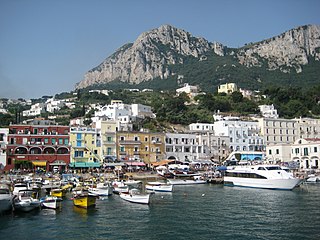
The Campo Cestio Cemetery, often referred to as the Cimitero Acattolico of Rome, or as the Cimitero dei protestanti or Cimitero degli Inglesi, is a private cemetery in the rione of Testaccio in Rome. It is near Porta San Paolo and adjacent to the Pyramid of Cestius, a small-scale Egyptian-style pyramid built between 18 and 12 BC as a tomb and later incorporated into the section of the Aurelian Walls that borders the cemetery. It has Mediterranean cypress, pomegranate and other trees, and a grassy meadow. It is the final resting place of non-Catholics including but not exclusive to Protestants or British people. The earliest known burial is that of a Dr Arthur, a Protestant medical doctor hailing from Edinburgh, in 1716. The English poets John Keats and Percy Bysshe Shelley, as well as Russian painter Karl Briullov are buried there.

The English Cemetery in Florence, Italy is an Evangelical cemetery located at Piazzale Donatello. Although its origins date to its foundation in 1827 by the Swiss Evangelical Reformed Church, the name "English Cemetery" results from the majority of its burials being Protestants from the British and American communities of Florence, and who gave the largest sum of money for the purchase of its land. The cemetery also holds the bodies of non-English speaking expatriates who died in Florence, among them Swiss and Scandinavians, as well as Eastern Orthodox Christians, among them Russians and Greeks. The cemetery is still owned by the Swiss Evangelical Reformed Church, and is open for the interment of cremated ashes, now of all Christian denominations, but no longer for burials.

The Fontanelle cemetery in Naples is a charnel house, an ossuary, located in a cave in the tuff hillside in the Materdei section of the city. It is associated with a chapter in the folklore of the city. By the time the Spanish moved into the city in the early 16th century, there was already concern over where to locate cemeteries, and moves had been taken to locate graves outside of the city walls. Many Neapolitans, however, insisted on being interred in their local churches. To make space in the churches for the newly interred, undertakers started removing earlier remains outside the city to the cave, the future Fontanelle cemetery. The remains were interred shallowly and then joined in 1656 by thousands of anonymous corpses, victims of the great plague of that year.
Clare Benedict (1870–1961) was an American writer and patron.

Capri is a municipality in the Metropolitan City of Naples situated on the island of Capri in Italy. It comprises the centre and east of the island, while the west belongs to Anacapri.
The English Cemetery, Il Cimitero degli Inglesi, or more correctly, Il Cimitero acattolico di Santa Maria delle Fede, is located near Piazza Garibaldi, Naples, Italy. It was the final resting place of many Swiss, Germans, Americans, Irish, Scottish and English who lived in Naples, were passing through on the Grand Tour, or were merchants or seamen.

TheCimitero Evangelicoagli Allori is located in Florence, Italy, between 'Due Strade' and Galluzzo.

The Cimitero Maggiore di Milano, also known as Cimitero di Musocco, is the largest cemetery of Milan, Italy. It is located in Zone 8, in the Musocco district, not far from the Garegnano Charterhouse. The cemetery has an overall area of 678,624 m2 with over 500,000 graves.
The Cemetery of the 366 Fossae or Cimitero di Santa Maria del Popolo or Cimitero dei Tredici was built in 1762 a short distance from the then-dilapidated Villa Poggio Reale, and is located on a terrace of a hill overlooking the Poggioreale neighborhood of Naples, Italy. It is near the monumental Cemetery of Poggioreale, which was built on top of the ruined villa. The architect was the Florentine Ferdinando Fuga.

The Polish Military Cemetery at Casamassima, was established in Casamassima, near Bari, in southern Italy, where there are about 431 graves of Polish soldiers and officers of the 2nd Polish Corps who died between 1944 and 1945. This small cemetery, mostly "Italian" in style, with decorative trees, is typical of the Mediterranean region and is located among surrounding vineyards.

The Cemetery of Poggioreale is one of the major cemeteries in Naples, Italy. It is also known as Camposanto Nuovo, to distinguish it from Camposanto Vecchio, which is now known as Cemetery of the 366 Fossae. It is bordered by the Largo Santa Maria del Pianto, Via del Riposo, Via Santa Maria del Pianto, and via nuova Poggioreale, and is built upon the ruins of Alphonso II's Villa Poggio Reale.

William Henry Herriman was an expatriate American art collector in Rome who, on his death, left important works of art to the Metropolitan Museum of Art in New York and the Brooklyn Museum.

Lucio Amelio was an Italian art dealer, curator, and actor. For decades he contributed to make Naples an international art centre encouraging the dialogue between European and American contemporary arts.

Harald Adolf Nikolaj Jerichau was a Danish landscape painter.

The Santa Maria Addolorata Cemetery, often known simply as the Addolorata Cemetery, is a state owned Neo-Gothic cemetery located in Paola, Malta. It is a multi-faith cemetery, but predominantly characterized by Catholic burials. It is the largest burial ground in the country and has been expanded a number of times. People of all social background are buried within the cemetery, and it consists from temporary memorial plaques of the death to permanent monuments including chapels belonging to private families. The cemetery also includes Commonwealth War graves.

The German Futa Pass Cemetery is Italy's largest war cemetery. According to the German War Graves Commission it holds remains of 30,800 German soldiers who died in the Second World War. It is located at the summit of the Futa Pass in the Apennines and in Mugello, near Traversa in the commune of Firenzuola, that is, about 40 kilometers north of Florence and 40 kilometers south of Bologna along National Highway Nr. 65 near the border of Tuscany and Emilia-Romagna.

















